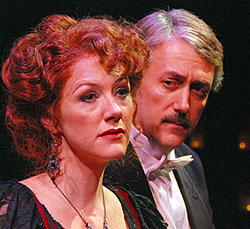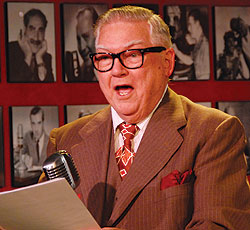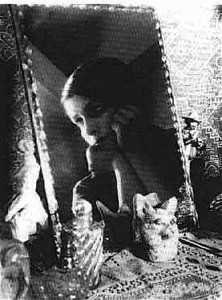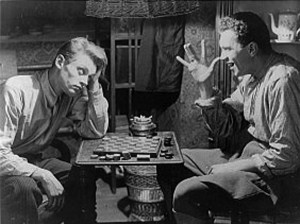Sweeney Todd Music Rehearsals
We celebrated the opening of Sweeney Todd last night. The performers were all outstanding, and the audience responded with a standing ovation. Afterwards we enjoyed a wonderful post show party hosted by gracious folks at Casa Guadalajara.
Over the past couple of weeks I have caught glimpses of the show in rehearsals, and watched as the entire collection of artists, one of the largest we’ve ever assembled at Cygnet, have come together to create an exciting evening of theatre. During that time I managed to also capture some video of the rehearsals, including the first time the cast and band rehearsed together, and the first rehearsals on the completed stage. Please enjoy this peek behind the scenes.
A Sweeney Blood Rehearsal
In order to test drive the special blood effects designed by resident artists Peter Herman, Shirley Pierson, Bonnie and Nick Durben for our production of Sweeney Todd, we held a little blood-letting one night at our rehearsal space.
We have two different methods of producing the Grand Guignol style blood moments in the show, depending on which character is being killed at which moment. Without trying to give away too much of the mystery, it took a little trial and error to much hilariously ghoulish laughter from the actors! Check out the video James Vasquez shot of our experiments. It’s a little gory, but a lot of fun.
Check the teaser on youtube!
Cygnet’s 8th Season!
We are delighted to announce our 2010/2011 line-up. Our eighth season will offer productions ranging from a world renowned classic to a world premiere and kicking it all off will be something never before done at Cygnet Theatre – a trilogy of connected plays performed in repertory!
To start the season, we will revisit the works of Alan Ayckbourn, author of our immensely popular production of Communicating Doors. This time instead of traveling through time, we will visit the same time as seen in three different rooms, all of which get their own play! The Norman Conquests – which includes Table Manners, Round and Round the Garden and Living Together – revolve around Norman a charming library assistant, and the women in his life. Each play stands on its own, however, the fun is in seeing the entire trilogy as each play reveals unique secrets, surprising answers and loads of laughs. Directed by Artistic Director Sean Murray and Francis Gercke, The Norman Conquests will run in rep with the same six actors from July 28th through November 2nd, 2010.
Five Things You Didn’t Know About Cygnet Theatre
 1. The Cygnet Theatre Name has a Cheeky Origin.
1. The Cygnet Theatre Name has a Cheeky Origin.
As most theatre buffs will tell you, the Globe Theatre in London has long-been considered one of the “most magnificent” theatres the city has every seen. Shakespeare’s legendary theatre was built in the 16th century by carpenter Peter Smith and his workers, and most arts-lovers of the day felt that no other theatre would ever match its accomplishments or stature. Nor did many dare try. The Swan Theatre became the Globe’s one major rival, continually striving to reach new heights in theatrical achievements, despite its later eminence. Artistic Director Sean Murray was inspired by this driven-and-able historical theatre, and has held in the highest regard Craig Noel, the founding director of San Diego’s Old Globe Theatre. As cygnet is the name for a baby swan, Sean liked the tongue-and-cheek title for his theatre. Cygnet Theatre may have begun as a fledgling playhouse in a strip-mall, but we’ve got some big ambitions and some real cheek.
2. There’s a swan in every Cygnet set.
We at Cygnet love our namesake. For this reason, every Cygnet set pays tribute with a swan hidden (and sometimes not so hidden) within the scenery. The very first Cygnet show – Hedwig and the Angry Inch – included a giant paper mache swan head made entirely of paper plates which guarded the band’s drummer. Copenhagen’s swan was displayed on the multiple chalk-boards. Set designer, Sean Fanning hand-drew a swan, along with notes, phone numbers and doodles on the Mauritius set’s bulletin board. Escanaba in da’ Moonlight featured crates with a company logo swan stamped on their sides and A Little Night Music continued the tradition with a swan carved into Frederick’s elaborate bed. Although they’re sometimes challenging to spot, the Cygnet swan will make its appearance in each and every season’s show. Just another reason to enjoy a look around your next Cygnet set.
3. There’s a Ghost in the House.
Sure we’re theatre people and drawn to the dramatic, but we can’t deny the feeling that we’re not alone in here. Our move to Old Town not only provided us some new digs, it seems that it came with a complimentary company member. Nothing to worry about, of course. The Old Town ghost – or Charlie, as he’s been named – seems to appreciate the entertainment. We assume it’s why he’s stuck around and made his presence known to other theatre companies who made their home at the Old Town Theatre before us. But he also seems to love a practical joke or two. While we’ve become accustomed to his slamming doors and bumps in the night, we do wish he’d return the various props and costume pieces that have gone missing from our latest Cygnet productions.

4. Sean Murray isn’t His Real Name.
Artistic Director Sean Murray isn’t who he says he is. His real name is Thomas Murray, but you tell that to Equity. In order to get his Equity card, he had to choose a name that wasn’t already in their system, and his middle name seemed to be the next best choice. Plus, Mama Murray was all for it. When he asked her what she thought his Equity name ought to be, she told him that although he was a fifth generation “Thomas Murray”, if she’d had her druthers, his name would have been Sean anyway. Of course, we love him as “Sean” as much as we’d love him as “Thom” but we DO wonder what else he’s not telling us.
5. Cygnet Theatre’s Wonderful Life Includes Some Real Radio Royalty.
Lovers of Cygnet Theatre’s It’s a Wonderful Life: A Live Radio Play, have come to recognize actor Jonathan Dunn-Rankin as cantankerous, old “Mr. Potter.” But listen closely and you’ll hear the golden pipes of real radio royalty in his between-scene radio announcements.

At only 17 years old, Jonathan began working in radio in 1940s Florida. He grew up to become one of the recognized, big-voiced 40s radio announcers of the era. That broadcast history eventually brought Jonathan to San Diego where he spent many years as KFMB’s principle television newscaster. Artistic Director Sean Murray remembers watching him on Channel 8 regularly, never realizing they would one day work together. Now Jonathan has become part of Cygnet’s annual holiday tradition. This will be his third year of bringing his life experience to the stage. As the station chimes play and he opens the show into the radio mike, don’t be surprised if you feel as though you’ve slipped back in time.
Cygnet Tech Pancake Breakfast
We enjoyed treating the cast to our tech pancake breakfast this morning. It is a way to start tech stress free, full of food, and time to bond.
Here’s my pancake recipe. No Bisquick for this one!
Sean’s Pancake Recipe
1 cup whole wheat flour
1/4 cup Ground Flax Seed (optional)
1/2 cup Oat Bran (optional)
Sprinkle of Wheat Germ (optional)
2 tsp. Baking Powder
2 Tbs. Sugar (or Splenda)
1/4 Tsp. Salt
Dash of Cinnamon
1 Large Egg
1 Tbs. Melted Butter
Vanilla to taste
1 Cup Milk (more or less to create the batter consistency you prefer)
Chopped Walnuts
Fresh Blueberries
Mix the dry ingredients in a bowl. Add the Flax and Oat Bran to taste. I eye it.
Add the egg, vanilla, and milk. For thinner pancakes go with a thinner batter (more milk), for thicker pancakes, a thicker batter (slightly less milk) Stir the liquids into the drys until the batter looks like you like it. Add the melted butter. Mix well.
Add the walnuts and blueberries.
Let it sit for a few minutes while the griddle gets hot.
Spray the griddle with Pam or something like that. You don’t want too much butter on the griddle.
Spoon the batter onto the griddle. When the edges begin to look cooked and small bubbles begin to form in the middle of the pancake, flip it over and let it finish cooking. Don’t let it burn!!
Add butter, of course and real maple syrup.
and above all, enjoy.
Revisiting “It’s A Wonderful Life: A Live Radio Play”

Our theatre is presenting a 1940’s radio version of the movie, It’s A Wonderful Life. We all know the movie. I remember the first time I saw the movie. In the olden days, before you could buy the video or dvd or see a movie on television, one of the ways to see an old classic was to catch it at a movie theatre that showed revivals. In San Diego when I was a kid, this theatre was the Ken Cinema in Kensington.
I was a freshman at San Diego State University at the time, and my best friend, Russell and I decided to go see It’s a Wonderful Life at Christmas time. Neither of us had actually heard of it before, believe it or not. This was well before the Wonderful Life TV blitz when you could not turn on the TV without seeing it on every channel. So, for me and Russell, this was a new movie.
Here’s what I remember: being so totally swept up in the film and all of those beautiful citizens of Bedford Falls that I actually forgot I was at a theatre watching a movie. The people around me disappeared. Russell disappeared. My popcorn disappeared. We had no idea that there was going to be an angel or the redemption of the average man. The existential journey of George Bailey took me totally by surprise. By the time the friends came pouring in at the end of the movie, I was as wrecked as I had ever been. Total tears. No, not tears. Sobs. Aching, side holding sobbing. The theatre’s house lights came up and I was jolted back to my own reality: I was not there in the Bailey living room celebrating life and family, but sitting in one of the Ken’s then-famously uncomfortable seats, sobbing and gulping and blinking tears out my dazed eyes. Okay, I was eighteen. I hadn’t had a lot of experiences yet. It’s kind of sweet in retrospect.
I turned around realizing where I was, and Russell, who was sitting next to me was far worse than me! Whereas I had started to come back to earth, he was inconsolable. He couldn’t get up. He was crying to hard, that we had to wait until the theatre emptied before we could leave. Only now, we are laughing through our crying because we begin to realize that it was, after all, just a movie, you know?
I STILL cry at that movie. The tears seem to come at different things as I get older and life’s journey becomes more clear, if it ever actually does become clear. I’ll let you know when I get closer towards the curtain call.
In the meantime, the story stirs up thoughts about life choices, career paths, how the smallest connection can be a turning point without your even knowing it. It raises questions about whether we’re all following a predestined path, or wandering alone blindly forward. Are all of those small turning points lined up for us in advance, or do we alter the predestined path every time we make a choice between two things? Are there infinite predetermined life paths, each completely valid? Or ultimately one life journey with all of our “choices” already made for us?
As long as we recognize the value of each person in our life and their contribution to shaping what we are, we also have to recognize our power over other people’s lives and how our contacts, no matter how small, can change their lives too. All of this is karmic, isn’t it? It’s A Wonderful Life celebrates how interconnected we are all, and that we are truly not alone in this world. We are surrounded by what we create, we ARE what we create, so create something you can be proud of!
I didn’t mean to get so… blah blah blah with this. I was going to write about working on the story as a play and working with wonderful actors to get all of these feelings to happen live on stage. But it brings out the romantic in me.
I love to watch the actors take the journey every time they do it. I never tire of the show. It starts as such a sweet show with its soda fountains, snow sledding, and dreamers. The darker questions in the story seems to come up from behind us while we’re not looking and without realizing it we are suddenly addressing the horrifying notion of non-existence: To be a complete void. No mother. No family. No identity. Nothing.
Tom Andrew, who has played George since our first production, takes this journey with his whole body and soul every night! I admire him so much for the depth of emotion that he shares in telling George Bailey’s story. And all of the other actors in the company, Jonathan Dun-Rankin, Veronica Murphy, Tim West, David McBean, Melissa Fernandes and Amanda Sitton bring each and every one of these rich characters to life as if they were a company of thirty. With the live sound effects provided by Scott Paulson and musical direction and accompaniment by Amy Dalton, this show has become very special to us and to our audience.
It’s A Wonderful Life is such a beautiful story to touch base with every year. It’s a great reminder for us to keep in mind that every tiny choice we make or contact we have with another human has giant consequences for us all. We are all interconnected. It is a wonderful life.
Millennium babies introduced to a new kind of interactive media… LIVE THEATRE!!!

“Ladies and Gentleman! Boys and Girls! Children of all ages! Gather ’round the flag pole in the Old Town Park and enjoy a 15 Minute performance of Living Shakespeare!”
Last Tuesday morning I snuck away from my usual Box Office abode and skipped over to the green in the middle of Old Town Park to watch our education departments regular performance of a 15 Minute Shakespeare. Here I was treated to a two-man rendition of that lamentable comedy, Pyramus and Thisby, from A Midsummer Night’s Dream.
Dressed in their authentic 1850’s garb, Actors Extraordinaire, Mr. Brian Mackey and Mr. Daren Scott gathered a group of touring 1st graders for a performance. A great relief to their exhausted teachers aids. Throughout the piece Brian and Daren hand picked 3 children to play the rolls of Lion, Wall and Moonshine, to the delight of their classmates.
Since birth, the adorable children of Generation Z have been inundated with mediated performance through movies, television and the internet. The habit of playing with real toys is becoming unpopular exponentially. The meaning of “live” performance has been reduced to a clip on YouTube, shot in one take. For these children, “actors” live on the other side of a plasma screen and remain inaccessible and impersonal. But not this time…
The children were fascinated, as if it were nothing they’d ever seen before. Their eyes remained fixed on Brian and Daren’s hilarious range of characters, voices and gestures, not to mention their giggling classmates that had been chosen by the actors to take the stage… or in this case grass.
These actors weren’t walled off by a pixelated screen. Instead of being separated from their entertainment the children were in the thick of it, interacting with the characters and becoming a part of the story as it unfolded before their young eyes. One little girl even captured the memory by recording the entire piece on her cell phone. Oh the irony!
“We are the Cygnet Players! We need an audience and we need a cast! Gather ’round one and all!”
I’ve been Advocated!
 When Sean Murray offered me a part in Noises Off, he didn’t have to go very far – he just strolled the ten feet from his office to the “Development Suite”, as we affectionately call the corner office that houses Development Director Veronica Murphy and myself. I casually accepted and continued working on my grant proposal, while internally turning cartwheels!
When Sean Murray offered me a part in Noises Off, he didn’t have to go very far – he just strolled the ten feet from his office to the “Development Suite”, as we affectionately call the corner office that houses Development Director Veronica Murphy and myself. I casually accepted and continued working on my grant proposal, while internally turning cartwheels!
I’ve been a part of the Cygnet team for over a year and a half, but this will be my first time appearing on the Cygnet stage, and I’m honored to be joining such an amazing cast in a production helmed by Sean. As Veronica’s part-time right hand, my workload typically consists of assisting with processing donations, grant writing, donor appreciations, special events, and of course, making our morning coffee! For the past few years, when my Cygnet day has ended, I drove off to theatres in Coronado, San Diego, Solana Beach, and Vista to do my acting and directing work. Now my commute consists of walking to the rehearsal space in the back of our offices!
Several times a year, Cygnet sends out various mailings. When we do, we send out a call to volunteers, I make some extra coffee, and we have a great time folding letters, stuffing envelopes, and adding labels and stamps. (Quick plug, we will be doing a mailing this week and need volunteers on Wednesday, June 10 from 9:30am-1pm – contact me at jason@cygnettheatre.com if you want to join us!). It’s always a fun time chatting about theatre with board members, donors and other people who just want to help Cygnet out.
Recently, I came into work to find out that I had been Advocated! One of those volunteers (with whom I had debated the pros and cons of San Diego, New York and London theatre) had chosen to sponsor me through Cygnet’s Artist Advocate program. Thanks, Marilyn!

This program allows donors to direct their donations to an artist of their choice (actors, directors, designers and stage managers). All monies go directly toward the artist’s salary. Since its inception, Cygnet has made paying a competitive wage to artists a priority. This is made possible through the support of our donors!
As I write this, we are nearing the end of our second week of rehearsals. We’re at that bumpy stage where we’re still trying to remember all of the lines; where we’re juggling plates of sardines, slamming doors that aren’t there yet, pretending to run up and down stairs that are really taped squares on the floor, all the while trying to create real people who are experiencing real chaos. It’s maddening, frustrating, overwhelming. In other words, it’s theatre! And I wouldn’t want to be anywhere else in the world.
So, a big thank you to Arthur & Marilyn Neumann, who helped make it possible for me to be a part of this wonderful production. And thank you to ALL of the Advocates who are sponsoring artists, casts, and even productions. In the Development Suite, we are always looking for new and fresh ways to thank people. Sometimes, the simplest can be the best: We could not do this without your support. Thank you.
Bed and Sofa Background
 Bed and Sofa began its life as the wonderfully scandalous 1926 silent film directed by Abram Room and starring three of the Soviet Union’s most popular actors. For most of the twentieth century, Room’s film received ritual mention in Soviet and Western film histories, but mostly as a footnote in the development of the new art of film.
Bed and Sofa began its life as the wonderfully scandalous 1926 silent film directed by Abram Room and starring three of the Soviet Union’s most popular actors. For most of the twentieth century, Room’s film received ritual mention in Soviet and Western film histories, but mostly as a footnote in the development of the new art of film.
In the 1970’s the movie began to be taken up by a newer generation of film historians, such as Molly Haskell, who began to see it as “one of the most extraordinary feminist films of that [the 1920’s] or any other time.” The film began to make the rounds of various film festivals and began to be recognized for its frank depiction of ‘real life’ and its startling naturalistic acting style. Early American film actors had found their way into new medium of film via the Broadway stage and the circus. The acting style that we often associate with the silent era is one of broad gestures and quirky movement. This was to be expected as that was how actors worked on the stages of their era without the help of microphones, electric stage lighting, and computerized scenery. They needed to be larger and more declamatory to be heard and seen from the balconies. But, film pioneers like D. W. Griffith and Abram Room were busy creating such novel conventions as the ‘closeup’ and the ‘cut away shot,’ and thereby inventing the need for an entirely new style of acting for the film.
And Bed and Sofa was certainly that. It was an experiment in how to tell a simple story on film with only one set, three actors and a hand held camera around the busy streets of Moscow. Room’s team spun a complex and shifting tale of a love triangle in a cramped apartment during a severe housing shortage in modern Moscow. The film was an indictment of the wave of utopian ‘free love’ that came in with the revolution and was being actively stamped out by the Stalinist regime of the 1920s.
When Volodya excitedly comes to the big city to begin work as a printer he is met with the rude shock that due to government regulations, he must have a permanent address in order to hold a job of any kind. And, there is this housing shortage plaguing Moscow. It’s a “Catch Twenty-Two” that is only broken when he happens upon his old friend Kolya in the street who offers him his sofa. When Kolya, his wife, Ludmilla and Volodya set up house in the tiny apartment, a string of shifting alliances, lovers and situations are set into motion.
 Polly Pen and Laurence Klavan’s adaptation of movie is a mini-masterpiece. They obviously spent a great deal of love and devotion to making this story over for the stage. To begin with, the lyrics are adaptations of the title cards in the film. These phrases and musical motifs repeat over and over again. Each new time they are sung, they take on a new context as the story deepens. It’s simple and yet, it’s very complex and extremely specific. They have managed to create a faithful reproduction of the film that still holds its own as a piece of live theatre.
Polly Pen and Laurence Klavan’s adaptation of movie is a mini-masterpiece. They obviously spent a great deal of love and devotion to making this story over for the stage. To begin with, the lyrics are adaptations of the title cards in the film. These phrases and musical motifs repeat over and over again. Each new time they are sung, they take on a new context as the story deepens. It’s simple and yet, it’s very complex and extremely specific. They have managed to create a faithful reproduction of the film that still holds its own as a piece of live theatre.
I’ve been a silent film fan for many years. When we produced this play in 2004, it was just our third production (of 37 now to date!). But it was so well received (by the few people who knew of our new company who actually saw it!), that it has remained one of the most often requested revivals we have. People who saw it ask to be able to see it again. Those who missed it have asked us for an opportunity to see what the fuss was about. We know this: It was due to Bed and Sofa that audiences began to discover what this new company was about and the kind of works we intended to create.
Revisiting it has been a great experience. Rather than a straight re-mount, this version of Bed and Sofa is entirely new. The new cast is different. The set is similar but different, and with the new capabilities of the Old Town Theatre, we are able to flesh this show out even further. It’s both bigger, and smaller. We’ve been enjoying this amazing opportunity to explore the silent film style of acting and story telling. We have been faithful to the original movie and watched it and studied it for inspiration. We admired the acting in the film and then took off and brought our own insights to the piece. We hope you enjoy the surprises in this highly unique mini-silent-movie-opera. It’s both big and small. Not another word.
Bed and Sofa First Run-Through
Today I went to see one of the first run-throughs of our next Old Town production, Bed and Sofa. It’s always fun to see a show for the first time, although this particular show was a bit more familiar to me than some of the others.
Bed and Sofa was first produced by Cygnet during our first season in May of 2004. At that time we had about 40 subscribers and a rather small following. Nevertheless, it was very well received and garnered numerous awards from the local critics including a best Musical Production award from both the San Diego Critics Circle and San Diego Patte Awards.
Cygnet has produced over 35 plays and musicals in our short 6 year history but I have to say that if I were to pick a favorite, Bed and Sofa would definitely be it. The music is wonderful and the book and style of the show are just so clever. It is no wonder that so many patrons have asked us to do a remount.
Now, onto the run-through. I had seen the previous production about 5-6 times so I know the play very well. This was one of the first run-throughs so I was expecting to see a lot of stumbles and a pretty rough take on the script. The productions usually get there but sometimes at this point in the rehearsal process it can be a little scary.
The truth is, though, the actors are very far along. The story is a compact 90 minutes with no intermission and once you get into it the whole thing just flies by. Today was no exception, even without the costumes and the set and all of the pieces that make the production full, I got totally engrossed in it. I really wasn’t all that surprised that they are doing so well. As we share our office with the rehearsal space all of us at the office have been hearing everything for weeks.
The cast consists of three actors that are all new to the Cygnet Stage. Lance Arthur Smith, who plays Kolya, Colleen Kollar Smith who plays Ludmilla and Jordan Miller who plays Volodya. They all have great voices and compliment each other well. We’re very happy to have found such a wonderful cast for this production and help us bring back this wonderful piece of theatre.
At this point I feel very excited about where the production will be in a few weeks when we open. Bed and Sofa is a truly unique theatrical experience and if you missed the first time I hope you’ll take this opportunity and see something really special in the theater.